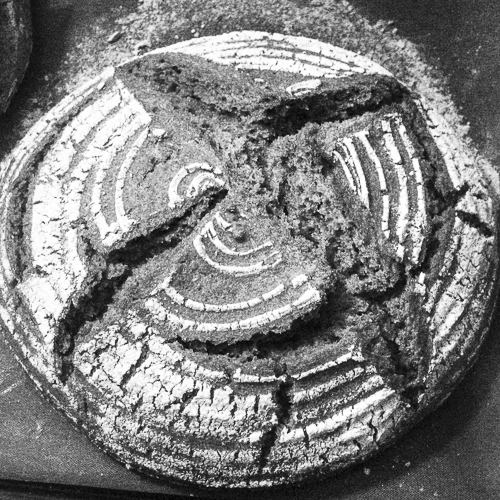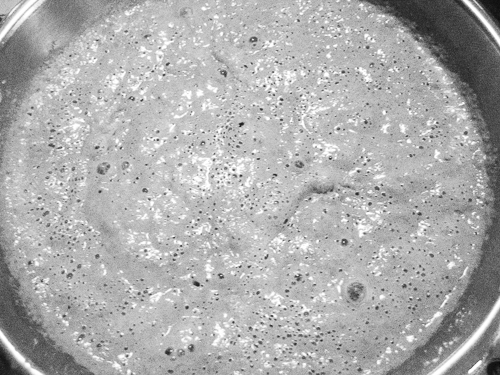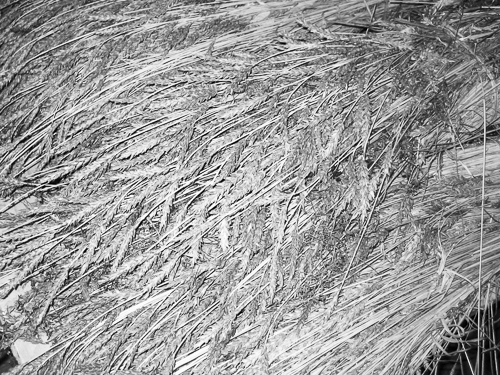I recently went to a bakery course at Aschim Vestre, a bio-dynamic grain farm of 300 acres in Hadeland, Norway. The course was arranged by Biologisk dynamisk forening and led by Kristin and Johan Swärd, who are renowned in Norway for cultivating old types of vegetables, potatoes and grain. All the cultivation is organic and all the products are sold directly from the farm together with flour, which has been milled at the farm. Flour is also sold at Økologisk spesialkorn.
About 10 students with varied background, ranging from someone who had worked as a baker for several years, active home bakers and me, who have still not started baking at home even after having went to two bakery courses, arrived at the kitchen of Kristin and Johan where the bakery course would take place.
Ideally, the course should have lasted two days, but due to limited time, everything should take place on a Saturday. Upon arrival, we were served freshly made bread rolls, next we should start making one sourdough bread each. Kristin had prepared a bowl of sourdough starter the day before and bubbles appearing and disappearing continuously were clearly visible on the surface.
We should mix the starter with flour of our choice and water. Contrary to the other bakery courses I have attended, we could select whatever type of flour we wanted. Having weighed a fixed amount of Dala wheat and mixed it with sourdough starter and water, it was time to start kneading. The first thing I had forgotten was to have flour on my hands, else the mixture, which should become dough got stuck to my hands. Next, I also had to add some water, then go on kneading. The other students made it look very easy, while I had to struggle, but in the end I had some dough with a respectable appearance. Finally, we should put the dough in a banneton, cover it with a cloth and let it leaven for some time.
While we were waiting for the leavening, Johan told us a little about old grain types like spelt which has long roots being able to find nutrients and water deep down, while modern wheat has short roots and is dependent on artificial irrigation and getting nutrients from fertilizers located close to its roots. In addition, spelt has a long stem, making it more difficult for parasites to climb from the ground up to the ear. Modern grain types have been refined in order to give a large harvest per area, but valuable characteristics have been lost at the same time. For instance, it’s possible to make bread with Dala wheat flour using recipes from the 1850s, while this is simply not viable using modern wheat.
This article in Danish states that harvesting old grain types originating from a certain area like Dala wheat gave about 10 tons of hay and 4 tons of grain per hectare, while nowadays harvesting results in 4 tons of hay and 10 tons of grains in conventional agriculture. In addition, the old grain types were cultivated with much less fertilisers than nowadays and with no pesticides.
According to agronomist Hans Larsson at the Swedish University of Agriculture Sciences the changes are caused by crop scientists who have succeeded in shortening the stem of the wheat plants significantly. He also says that the percentage of proteins in the grains have fallen in accordance with the shortening of the stem because it’s the nitrogen in the stems, which gives protein in the grains.
The old grain types have, contrary to modern types of grain, large leaves which limit the amount of light which can be used for growth by unwanted weeds. The long stems also make it more difficult for diseases to spread. Besides, they have a larger genetic diversity, which is the best protection against diseases.
This article in Danish states that genetic diversity leads to that the plants can adapt to local conditions and it’s more difficult for plant diseases to harm all the plants when they are different.
Next, he talked about what’s happening in a dough and what it consists of. Two of the main parts of dough are gluten and starch.
Gluten (from Latin gluten, “glue”) is a composite of storage proteins termed prolamins and glutelins and stored together with starch in the endosperm (which nourishes the embryonic plant during germination) of various grass-related grains.
Gluten is appreciated for its viscoelastic properties. It gives elasticity to dough, helping it rise and keep its shape and often gives the final product a chewy texture.
Gluten enables dough with yeast to leaven because it forms a network of small walls which confines carbon dioxide and water vapour inside the dough. It also works as a binder in the dough, making it easier to work with.
Starch also interacts with gluten during baking. The gluten breaks down and gives up water which is quickly taken up by the starch. This makes the gluten set and become rigid, which is why our loaves of bread don’t collapse when they come out of the oven.
He also told us that we need to add salt to the dough amounting to about 1% of the weight of the flour. When salt is added, more flavour results and the speed of leavening is limited. This can also be obtained by cooling the dough during leavening.
As noted here in Norwegian, only grain types which normally aren’t cultivated any more, are grown on this farm. These types of grain aren’t actively refined and they are probably more or less identical to grain which was grown in the Bronze age. Old types of grain contain gluten which is much softer than the modern, hard gluten, and it’s better for many people’s digestion. All in all, 80 types of grain have been grown on this farm, some of which include einkorn wheat , emmer, spelt, Nordic rye called svedjerug Dala wheat (a type of wheat from Dalarna in Sweden), black oat (actually two types of oat which were brought by emigrants from Norway to Canada in the 1800s and back to Norway recently), naked barley (that is, barley without hull) and many others.
As told in this video essay, old grain types need to be grown and not stored in a seed bank. Living material in nature will develop, change and adapt to environmental conditions. Farmers have been developing grain for millennia, while now big companies do it, but it’s important that farmers together with consumers take back this control.
When Johan started growing old types of grain and brought it to a modern flour mill, it was rejected because a modern flour mill will only accept modern types of grain. The alternative was to buy his own flour mill and after a lot a of trial and error, he’s able to produce flour, which is much sought after. Anyway, before the grain can be turned into flour, it has to be threshed. That is, removing the seeds from the stalks and husks.
Johan told us that he could of course bring his grain to the nearest industrial flour mill and have it threshed there, but that would give a yield of only about 70%, which he can’t accept. Instead, he has bought some second-hand threshing machines: one from Belarus and another one from Sweden, both of them more than 70 years old. In addition, there were lots of machine parts lying around, which I guess may be used for assembling another one.
Actually, threshing the grain by means of those old machines entail a major part of turning grain into flour. A modern way of cleaning wheat can be found here. After having threshed the grain, Johan brings it to one of his three flour mills, while modern flour mills first have to measure the falling number, which gives an indication of the amount of sprout damage that has occurred in a wheat sample, before milling can start.
According to the United States Department of Agriculture, the relation between falling number and sprouting indication in a grain of wheat is the following:
|
Falling number (sec) |
Sprouting indication |
|
More than 300 |
No sprout damage |
|
Between 200 and 300 |
Some sprouting |
|
Less than 200 |
Severe sprout damage |
A commercial flour mill can’t accept a low fall number, while a farmer like Johan doesn’t need to think of this because old grain types can withstand much more rain than modern ones. Thus, some years ago there was a very rainy summer and autumn in Norway where a large part of the wheat harvest had to be used as animal feed, while the old grain types could be turned into flour for human consumption.
Next, when the grain is ready for milling, three flour mills are ready for use. Two of them are stone mills with composite stones and one of them has three flour sifters such that the flour can be sorted according to the size of the particles. During milling, the flour is collected in paper bags and packaged, ready for sale.
In addition to the stone mills, there is a third flour mill at this farm. Interestingly, this is a vortex mill, which was invented by the Austrian Viktor Schauberger. According to this text in Norwegian, the grain is driven around in a rotating chamber where the grains are gradually ground to a finer size than is possible in a stone mill and the grain is kept at room temperature. Johan told us that when the grain particles are sufficiently small such that the force of an applied air pressure is greater than the centrifugal force, they will be blown into a sack of cloth and fall down into a paper bag. Unsurprisingly, this type of milling is slow and only 10-15 kg of flour are produced per hour.
We were also told that customers should ask the miller about advice on the flour and Johan sometimes receives phone calls from customers who tell him that the flour was good, but … Thus, in addition to cultivating old types of grain, threshing and milling it, Johan also has to advise his customers on making bread with his flour.
Having looked at the flour mills and the threshing machines, Johan also showed us the loft where he lets various old grain types dry. He’s cultivating areas of 100-200 square metres with old grain types and he’s harvesting them by means of a sickle. Since 1 kg of seeds may be turned into 15 kg grain, he’s able to multiply the number of seeds after a few years. For those who want to grow old types of grain, Johan sells 1 kg of seeds per person and sort. He can be contacted at: gardsmolla@gmail.com
Afterwards, we went back to the kitchen where our bread dough were ready to be baked. Just before putting them in the oven, Kristin made a crossed cut in the dough in order to let the dough expand in a controlled way. When the finished breads were taken out of the oven, they all had a symmetric shape and they looked and smelled delicious, while mine had a quite irregular shape. Anyway, as long as the taste and fragrance were good, I was satisfied.
In the end, Johan drove us back to the railway station such that we could go home by train.



